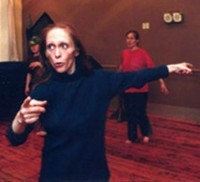Ecclesiastical drama "Aabraham"
Ecclesiastical drama by Hrotsvit of Gandersheim "Aabraham" (10th century)
Festival project: Director:Anne Maasik, leading roles: Raivo Adlas, Eevald Aavik, Miina Laanesaar, Anu Ander; music provided by "Festivitas Artium. Schola".
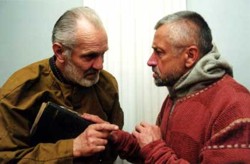
The name of Hrotsvit of Gandersheim would probably ring no bells for an Estonian who is not a philologist or a medievalist. The writings of this woman who lived more than a thousand years ago (c. 935-972) have not been available in Estonian so far. She was probably not widely known in her lifetime either as the only known manuscript with her work was found by the humanist Conrad Celtes in St Emmeran's monastery only in 1493 and it was published in 1501.
Hrotsvit came from the German aristocracy and lived in the Gandersheim Benedictine nunnery where the abtess persuaded her to write down in Latin the history of the nunnery (Primordia coenobii Gandersheimensis) and a longer a poem about the heroic deeds of Emperor Otto (Gesta Ottonis). She has also recorded in hexametres eight legends about saints (in the manner of Virgil and Ovid) and written six plays with the following introduction: There are many Catholics to be found who prefer pagan books to the holy ones for their elegant style and this is a circumstance which we can never adequately explain away. There are others who stick to the Scriptures and although they deride the pagans, they still often read Terence's fables; while they enjoy his smooth language, they let themselves be contaminated by learning ungodly things. Thus I, the Loud Cry of Gandersheim, have not refused to imitate him while others pay their respects by reading him; that is why in the same manner in which the foul deeds of pampered women are recited the chaste and laudable deeds of holy virgins are described. /---/
The dramas are written in rhythmic prose the periods of which frequently rhyme, though not always happily or noticeably. The text is full of quotations from the Old and New Testament, paraphrases, religious turns of phrase, liturgical reminiscences etc. Besides the ancients, also the influence of later poets (above all Prudentius) and prose writers (Boethius, Bede, Alcuin and others and the Church Fathers) is noticeable. The dramas were originally untitled, equipped as they were with a small synopsis in the manner of Aristophanes. In later times they started to be referred to by the protagonists: Gallicanus, Dulcitius, Calimachus, Abraham, Pafnutius, Sapientia. She wrote six plays to counteract to pagan influence of Terence's six comedies. Her plays can also be tentatively called comedies but they in no way ridicule the values of Hrotsvit''s own Christian way of life but those of the secular world, using the technique of situational comedy. In great probability the plays were never performed in the Middle Ages, the texts were meant for the educated reader. The Germans think very highly of Hrotsvit, considering her to be the very first German poetess and today her plays are successfully performed.
Anne Maasik
 Anne Maasik has worked as a stage and theatre director for 23 years, thirteen of them at the Theatre Vanemuine as an actor and music director. While working at the Vanemuine she staged two solo programmes and taught at the drama studio there. She also worked as an actor at the Tartu Children's Theatre where she has staged plays both for children and grown-ups and again put together four solo programmes of songs. She has acted as music director for Rein Maran's nature films. The Estonian public knows her first of all as a very original singer. Her songs are characterized by a total immersion in the text and a very sensitive and powerful performance. Her style joins together the traditional Finno-Ugric song tradition and a deep feeling for nature. Many of her songs have been used as background music for various plays. She has also issued a CD and two cassettes with her songs.
Anne Maasik has worked as a stage and theatre director for 23 years, thirteen of them at the Theatre Vanemuine as an actor and music director. While working at the Vanemuine she staged two solo programmes and taught at the drama studio there. She also worked as an actor at the Tartu Children's Theatre where she has staged plays both for children and grown-ups and again put together four solo programmes of songs. She has acted as music director for Rein Maran's nature films. The Estonian public knows her first of all as a very original singer. Her songs are characterized by a total immersion in the text and a very sensitive and powerful performance. Her style joins together the traditional Finno-Ugric song tradition and a deep feeling for nature. Many of her songs have been used as background music for various plays. She has also issued a CD and two cassettes with her songs.
"Meister Rumelant - Minnesinger at the Danehof Court"
Chivalrous entertainment from the time of king Erik Menved.
GIt happened in Jutland, up in the north ... Faithful Danes, seek revenge for your king, praise and honour will you recieve in return.g The King is Erik Klipping, who was brutally murdered on the night of November 22, 1286 in the small village Finnerup in Jutland, and the words are from one of the ten songs which have come down to us from the work of the German minnesinger Rumelant. Three of these songs describe these dramatic events, and they were most probably sung at the Danish court in Nyborg Castle in 1287. Thus, they are a remarkable example of words and music which had sounded in the Denmark of the Middle Ages. The language is German, which is not surprising considering the rich cross-cultural exchange between the Danish court and noblemen and their German counterparts, much like in the rest of Europe at the time.
But who was this Rumelant? He was not a nobleman like many of his singing colleagues, but is called Meister, i.e. a professional musician. Rumeland's artist name, meaning Gescapee of the landg, refers to his status as a travelling singer, and the texts indirectly refer to where his travels had taken him: Frankfurt am Main, Schwerin, Braunschweig, Mecklenburg, Pommern and - Nyborg. We know nothing more of his life. However, in a manuscript from around 1300 (Manesse codex) there is a portrait. Here he is depicted, about to mount his horse saying goodbye to a nobleman. The picture above it gives a glimpse of Rumeland's everyday life. A woman and two men hold hands while performing a courtly dance, being accompanied by a flute and a fiddle. Together with the serious songs, there could be no better illustration of how the travelling musician filled many functions, and the kind of versatility expected of them during festivities at Nyborg Castle - from complicated declarations of love to the woman and praising of his lord, to moralizing and propagandist songs, instrumental virtuosities, common and unrestrained dancing.
ALBA can offer an evening in company with Meister Rumeland fair songs, spiced with catching instrumental arrangements, all mingled with quotes from the songs and others lyrics of the time.
Alba
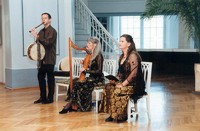 ALBA was formed in connection with the first Copenhagen Early Music Festival in 1992 and the Spanish exhibition at the art museum Louisiana the same year. Thus, a Danish professional medieval ensemble was born. From the first, ALBA has focused on the task of mediating the music of the Middle Ages in such a way that it can captivate the modern audience as an art form, not just a historic curiosity. By examining surviving original sources of both writings and visual arts, and by studying the still living musical traditions with roots in medieval times, ALBA first of all searched for the timeless state of emotion, which in spite of the distinctive character of both the music and the instruments, lives in music from all times. They then flavour it with a mixture of authenticity and personal expression.
ALBA was formed in connection with the first Copenhagen Early Music Festival in 1992 and the Spanish exhibition at the art museum Louisiana the same year. Thus, a Danish professional medieval ensemble was born. From the first, ALBA has focused on the task of mediating the music of the Middle Ages in such a way that it can captivate the modern audience as an art form, not just a historic curiosity. By examining surviving original sources of both writings and visual arts, and by studying the still living musical traditions with roots in medieval times, ALBA first of all searched for the timeless state of emotion, which in spite of the distinctive character of both the music and the instruments, lives in music from all times. They then flavour it with a mixture of authenticity and personal expression. Much like the travelling musicians of medieval times, ALBA does not demonstrate a great variety of plausible (and implausible) instruments, but does both vary and contrast their music with a virtuous and subtle control of the innumerable possibilities of their instruments. Their programmes expose the countless colours and diversities of the Middle Ages, often with a mixture of both words and music.
ALBA can be heard as a duo with Agnethe Christensen and Poul Høxbro or as a trio in company with the singer and harpist Miriam Andersén. A concert with ALBA is an invitation to experience the refinement of the Middle Ages, with music for both body and soul.
Märt Läänemets
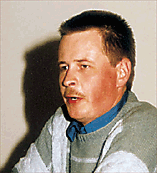 Märt Läänemets was born in 1962. He graduated from the University of Tartu in 1985 as a psychologist. He studied Oriental languages at the Centre of Oriental Studies under Linnart Mäll and Maret Kark, in 1992 and 1998 and again from 1992 to 1993 he studied in China. At present he is a research worker at the Centre and the Vice-President of the Estonian Academic Society of Oriental Studies. His field of research is the study and teaching of the Chinese language and culture.
Märt Läänemets was born in 1962. He graduated from the University of Tartu in 1985 as a psychologist. He studied Oriental languages at the Centre of Oriental Studies under Linnart Mäll and Maret Kark, in 1992 and 1998 and again from 1992 to 1993 he studied in China. At present he is a research worker at the Centre and the Vice-President of the Estonian Academic Society of Oriental Studies. His field of research is the study and teaching of the Chinese language and culture.
Dayan Naxi ancient music
Dongjing music was used by literati in ancient China as part of elaborate musical ritual activities. Disciples of Confucius used it to promote inner peace. Taoists adopted it for physical and spiritual exercises. The main scripture used is the "Transcendent Scripture of the Great Grotto of Wenchangg (Wenchang Dadong Xianjing). Wenchangis the patron god of the literati.
During the Ming (1368-1644) and Qing (1644-1911) dynasties, Dongjing music was popular among the educated elites. During the Jiajing period (1522-66 AD) of the Ming dynasty, the headman of Naxi, Yunnan brought Dongjing music into the Yunnan Province from Nanjing, Fujian and Sichuan. In the late Qing dynasty, with the spread of western knowledge, Dongjing music almost ceased to exist in Central China. Fortunately in the remote and isolated area of southwest China, known as Lijiang, the Naxi people continued to enjoy Dongjing music.
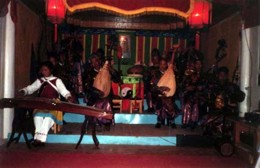
The Dayan Naxi Ancient Music Association was officially established in 1987 by the Dongjing specialists Xuan Ke, He Yi'an and Yang Zenglie to carry out research and promote Dongjing as well as to train young players. Its debut concert in July 1988 and subsequent performances have aroused much attention and interest in China and among overseas scholars and music lovers. In 1995 the group toured in the UK.
The group enjoys the prestige of having "three old rarities": old music pieces, which date back to the Tang dynasty (618-906), ancient and authentic instruments, and elderly musicians.
Prof. Xuan Ke
President of Dayan Naxi Ancient Music Association.Folk musician Xuan Ke was born in Lijiang, in the Yunan Province, in 1930. He is of the Tibet-Naxi nationality. He devoted his youth to studying music but recognition was slow to come, he achieved it only comparatively late in life. His multi-ethnic background has given him a wider perspective than is common in multi-racial questions and his knowledge of many languages is of great help here.
Folk Musician, Xuan Ke was born in Lijiang, Yunnan Province in 1930. He is of the Tibet-Naxi nationality. As a young man, he studied music most of his life. "A great man who was found success in his latter years" is common evaluation of him in academic circles. His multi-ethnic background makes him clever and ambitious. He speaks many languages, and he is able to understand and think about questions from many different ethnic viewpoints. After experiencing many ups and downs, he has formed a positive attitude towards life and acquired an enduring thirst for knowledge.
Though already 70 years old, Mr. Xuan Ke is still highly spirited. He has visited many universities to study and lecture, including London and Oxford Universities, the China Central Conservatoire, the China National Academy of Music, Sichuan Academy of Music, Yunnan Institute of Nationalities, Yunnan University, and the Music Association of Guangdong Province. The subjects of his lectures include Study on Music's Origin and Methodology, Civilization and Culture of the Naxi Nationality, Study on Dongjing Music of Lijiang and Study on Baishaxi Music. He has published several theses, including "Music and Dance Originated from the Fearof Our Ancestors", "Chorus Proceeds Unison", and "The Ancestors of the Naxi are not Qiang".
Laterna Magica
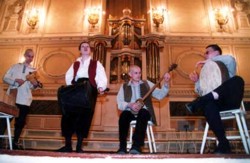
"Melpomen" - Ancient Greek Music
Music for a 5th-century BC symposion, reconstructed and newly created by: Conrad Steinmann on aulos, with Luiz Alvez da Silva (song, alto) and Massimo Cialfi (tympanon, kymbala, salpinx).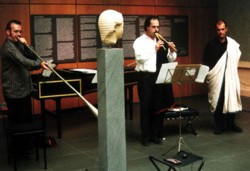
The dances, nomoi and monodies by classical Greek lyricists (Bacchylides, Simonides, Pindar, Terpander).
A question may arise why we should want to perform such ancient music today. And is the whole thing not pure speculation anyway?
What is the abiding attraction of such an enterprise? Where is the most appropriate key to the sounds, melodies and rhythms to be found? Where can the project which unites musical archeology and practice coupled with historical imagination take us in the end?
It is possible to gather an astonishing amount of material about the outward musical side of a 5th-century symposion. From various sources we can learn what people
To be charmed and inspired by some historical epochs or by one's own past, is an extravagance indulged in for various reasons. Interestingly, in recent years the influence of ancient Greece can be traced in various fields of art and science.
For years now I've also been involved, together with the instrument-maker Paul J. Reichlin, with the "material" side of things - wood, the measurements of instruments and the logic of their construction. Proceeding from the assumption that every instrument has perfectly corresponded with the needs of the musicians and the music of their period, and consequently every detail, even the smallest, must have a technical and musical function, we have let ourselves be guided by our concrete material. We adhere to the principle that every step must logically follow from what has gone before. This applies both to handicraft side of our job and to posing questions generally. For instance, the outsider's first question usually is what sequences of sound and intervals were actually produced by the aulos. This is obviously also my own first consideration when I start to play the instrument. But it is even more important to us that what I do follows logically from our research earlier. The music as I envision it, and what follows, is based above all on the possibilities offered by the instrument. The same applies to playing techniques.
On the one hand we are guided by the sounds, tones and melodies produced by the few surviving 5th-century auloi, but also by innumerable, and to our mind, very explicit vase paintings. On the other hand, Classical Greek tells as much about its own rhythmics, and, through word stress, about the melody of speech. Thus, our guide and inspiration for this Symposion-programme has been the poetry and songs of Simonides, Bacchylides, Terpandros and Aeschylus. My experience with the music of Aeschylus's drama Prometheus has given me an idea of what the treatment of tempo and time might have been like.
Time, tempo, rhythm, and the poetry itself, lead us naturally to instrumental pieces, the nomoi and dances. A number of percussion instruments, like the tympanon, kymbala or krotala, in their own way support the rhythmical pattern, or mode. The playing poses on the vases coupled with surviving playing techniques from regions of former Hellas (like South Italy) yield convincing results. Mediterranean singing techniques which have survived relatively unchanged for centuries, when supplemented with information gained about singing poses from the vases, and the specific sound of the aulos, revive monodies which have long kept their silence.
The ensemble of Conrad Steinmann

Luiz Alves da Silva was born in Brazil in 1964. It was there that he received his first music tuition. In 1982 he won first prize in the Competition for Young Singers held by the Sao Paulo Symphony Orchestra. From 1983 to 1989, Luiz Alves da Silva studied at the Schola Cantorum Basiliensis with Kurt Widmer (singing), Christoph Schmidt (Gregorian music) and with Hans Martin Linde (choral conducting). In 1989-90 he was a member of the international Opera Studio in Zürich. He has won study prizes of the Migros Cooperative, the Ernst Göhner Foundation and of the President's Department of the City of Zürich.
He gives many concerts throughout Europe, as for exemple with the Clemencic Consort of Vienna, the Istitutioni Harmoniche of Bologna, the Ensemble 1492 of London, the Ensemble Turicum of ZĂĽrich, and Hesperion XX and Capella Reval in Barcelona under the direction of Jordi Savall, with whom he has participated in many recordings.
In December 1990, Luiz Alves da Silva sang the title role in Mozat's opera Ascanio in Alba in the Konzerthaus in Vienna. Further engagements in the concert and opera circuit took him to the Ulm City Theatre (Ligeti's Le Grand Macabre), to the Théâtre des Champs Elysées in Paris, the Zürich Opera House (Ligeti's Le Grand Macabre, Händel's Deidamia), to the Music Theatre of Bienne (Britten's Midsummer Night's Dream), to the Concertgebouw in Amsterdam, to the Gulbenkian Foundation in Lisbon, to Galway and Kikkeny Festivals in Irland, to the Victoria Hall in Geneva, The Filharmonia in Warsaw, the Auditorio Nacional in Madrid, the Styriarte in Graz, the Teagu Festival in South Korea, the Amazonas Theatre in Manaus, the National Theatre of La Paz, etc. In collabaration with Swiss RadioDRS 2, Luiz Alves da Silva has made several world pemi?re recordings with the Ensemble TURICUM that he founded himself, as for example of the Stabat Mater by Giovanni Gualberto Brunetti (PAN Classics) as well as three CD's with Brazilian music from the colonial period (Claves and K617)
Massimo Cialfi was born in 1960 in Milano, Italy, where he followed his first musical training. Further studies in baroque trombone led him to Den Haag (NL) and to the Schola Cantorum Basiliensis, specializing to early repertoire, for exemple the Alta Capella. Beside his trombone carreer he is mostly interested in old arab percussion imstruments, wich makes him a well seen member of various Early Music ensembles, mixing traditional techniques with scientific knowledges.
Conrad Steinmann was born in Rapperswil in 1951 and studied recorder at the Schola Cantorum Basiliensis. In 1972 , he won first prize at the International Recorder Competition in Bruges in Belgium. From 1975 to 1982, he taught at the Zürich Music Academy. In 1982, he was appointed to the staff of the Schola Cantorum Basiliensis. In 1991 he was awarded the Arts Prize of the C.H.Ernst Stiftung in Winterthur. Conrad Steinmann is a member of the recorder ensemble'diferencias'. He received particular impetus from his singing lessons with Kurt Widmer, from his work with Nikolaus Harnoncourt, and from his work as performer and concert organizer of contemporary music. He has given the world premi?res of numerous works that were written for him, by for exemple M. Käser, R. Kelterborn, H.Marti, R.Moser, U.P.Schneider, P.Streiff, M.Wehrli, B.Trümpy, H.U.Lehmann and V. Ekimovsky. He is particularly interested in the research into and resurrection of the music of the Ancient Greeks.
Conrad Steinmann
Conrad Steinmann was born in Rapperswil in 1951 and studied recorder at the Schola Cantorum Basiliensis. In 1972 , he won first prize at the International Recorder Competition in Bruges in Belgium. From 1975 to 1982, he taught at the Zürich Music Academy. In 1982, he was appointed to the staff of the Schola Cantorum Basiliensis. In 1991 he was awarded the Arts Prize of the C.H.Ernst Stiftung in Winterthur. 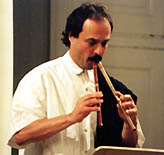 Conrad Steinmann is a member of the recorder ensemble 'diferencias'. He received particular impetus from his singing lessons with Kurt Widmer, from his work with Nikolaus Harnoncourt, and from his work as performer and concert organizer of contemporary music. He has given the world premi?res of numerous works that were written for him, by for exemple M. Käser, R. Kelterborn, H.Marti, R.Moser, U.P.Schneider, P.Streiff, M.Wehrli, B.Trümpy, H.U.Lehmann and V. Ekimovsky. He is particularly interested in the research into and resurrection of the music of the Ancient Greeks.
Conrad Steinmann is a member of the recorder ensemble 'diferencias'. He received particular impetus from his singing lessons with Kurt Widmer, from his work with Nikolaus Harnoncourt, and from his work as performer and concert organizer of contemporary music. He has given the world premi?res of numerous works that were written for him, by for exemple M. Käser, R. Kelterborn, H.Marti, R.Moser, U.P.Schneider, P.Streiff, M.Wehrli, B.Trümpy, H.U.Lehmann and V. Ekimovsky. He is particularly interested in the research into and resurrection of the music of the Ancient Greeks.
The Greek aulos
The aulos with a double reed mouthpiece is an ancient Greek wind instrument. In 5th and 6th-century Athens there was not a single public ceremony or theatre performance, nor a sports or cultural event where it was not heard. Judging by scenes on many painted vases, especially those from around 500 BC, also by written records and a few surviving instruments, the sound of auloi must have been very peculiar, ranging from irritatingly shrill to deliciously sweet. This seems to imply that ?aulos' really denotes a group of differently-made instruments which were always played by professional and highly praised musicians.
Judging by scenes on many painted vases, especially those from around 500 BC, also by written records and a few surviving instruments, the sound of auloi must have been very peculiar, ranging from irritatingly shrill to deliciously sweet. This seems to imply that ?aulos' really denotes a group of differently-made instruments which were always played by professional and highly praised musicians.
Having been enthralled by this instrument for ten years now, we - the very sensitive and skilful instrument maker Paul J. Reichlin and myself as a player and, in various senses, an ?interpreter' - have familiarized ourselves with its different sounds. Our experience, whether at the bench, in a concert hall or at the desk studying ancient Greek songs and dances, has convinced us that the approach to this group of ancient instruments is proof that today's instruments are aulos's remote descendants. A mention could be made here of the Sartish triple launeddas which is played with the so-called raised tongue, or the double flute from Calabria, a region which was once part of Hellas. These instruments mediate to us also playing techniques which correspond very convincingly to needs posed by ancient Greek rhythms and melodies.
"Novel", unused or virtuoso sounds and techniques reach us in this way and are of interest not only to specialists. Suddenly sounds which seemed to have ceased so long ago and for ever, come vibrantly to life.
Agnethe Christensen
Agnethe Christensen, alto, comes originally from Sweden and has her roots in both classical and folk music. She studied at the Royal Danish Academy of Music and Schola Cantorum in Basel, and has participated in a large number of solo recordings for different radio stations and for CD productions, as well as giving concerts and master classes in early music. She also appears at the opera stages performing mainly modern and baroque opera.
Miriam Andersén
 Miriam Andersén discovered medieval music when participating in the vocal ensemble GSchola Gregoriana Holmiaeg. Before going to Schola Cantorum in Basel, she studied calligraphy and book-binding in London, worked as a calligrapher while also gaining experience with theatre and circus. Today, Miriam Andersén works as a freelance musician with medieval ensembles, e.g. Real, Sarband, Ensemble Ferrara and Discantus, but still at her agenda are theatre and experimental music projects.
Miriam Andersén discovered medieval music when participating in the vocal ensemble GSchola Gregoriana Holmiaeg. Before going to Schola Cantorum in Basel, she studied calligraphy and book-binding in London, worked as a calligrapher while also gaining experience with theatre and circus. Today, Miriam Andersén works as a freelance musician with medieval ensembles, e.g. Real, Sarband, Ensemble Ferrara and Discantus, but still at her agenda are theatre and experimental music projects.
Aristophanes' comedy "Birds"
Aristophanes' comedy "Birds" (Vth c. B.C.) - prologue and parodosFestival Project: Directors: Mari Murdvee & Heli Kohv, leading roles: Ergo Västrik, Tarmo Tabas, Heikki-Rein Veromann; music provided by Conrad Steinmann (Switzerland) ja Massimo Cialfi (Italy)
Eleven comedies by Aristophanes have survived from antiquity. Not all of them have as yet been translated into Estonian, and are consequently relatively unknown. The Birds was first performed in Athens during a Dionysia in 414 BC and it is his longest comedy (1765 verses). The text was performed by three actors who played twenty-two parts, and the choir, plus a number of silent actors. The protagonist took only one role, that of Peisthetairos, the rest were taken by the other two actors. The choir was dressed as birds. As at the present festival only a fragment of The Birds is performed, the prologue and parodos (the entrance of the choir), we include here a synopsis of the complete text.
Two Athenians, Euelpides and Peisthetairos, leave the town in search of hoopoe Tereus who had once been human, but according to legend, had been turned into a bird. The men want to ask Tereus whether he could suggest a more comfortable city for them to live in, where there are no taxes or litigation. When they find Tereus, who turns out to be the king of birds, Peisthetairos convinces him that a new city should be established - the polis of birds which should hang in the air between men on earth and the gods on the Olympos. Through such location of the polis the birds would get power over both the humans and the gods, as the sacrificial smoke from the earth would not reach the gods above. Tereus is fascinated by the plan. He summons all birds to ask them for advice. The birds are used to looking upon humans as the bitterest enemies and initially want to tear them to pieces but Tereus's gift of persuasion tames them and they receive the two men (prologue and parodos). Peisthetairos claims that birds had originally been gods but later they had lost their power and instigates them to proclaim war on Zeus (agon). The city is built, walls are raised and the name of the new city would be Cloudcuckooborough. A rumour about the new city has reached humans and observers start to arrive: Poet, Fortuneteller, Surveyor, Seller of Laws, Special Envoy (parabasis). The Messenger from the construction site gives a survey of the work done, another Messenger announces that a messenger from the gods has come by who turns out to be Iris. She is given an ultimatum for Zeus and is banished with shame. A Herald comes from the humans and brings a gold wreath to Peisthetairos in acknowledgement of his wisdom and tells that there is a cult of birds on earth, people give each other birds' names and will arrive soon to demand feathers for themselves. Then come Fatherbeater, Kinesias the Dithryamb-maker and Informer who want to live with the birds but they are likewise sent away. Prometheus brings word that Zeus seeks a reconciliation. Poseidon, Heracles and Triballos the King of Thrace arrive to offer a truce and accept Peisthetairos's conditions who gets Zeus's sceptre and marries the beautiful Basileia (the little parabasis). The choir sings epithalamiums and rejoices that the gods have been defeated (exodus).
To stage The Birds in its entirety would demand a great effort from the translator, director, actors, stage designer, musicians and also from the spectators, because the time distance is too great and an effort has to be made to understand and interpret the play. For these and other reasons Estonians have no tradition of staging Aristophanes, actually no tradition of staging ancient plays at all. In other parts of the world it is quite common, this year The Birds is for instance staged in London. I believe that Estonians would be more interested in Aristophanes if the texts were available in Estonian. So far only full translations of The Knights and The Clouds by Uku Masing have appeared in The Anthology of Greek Literature and an extract of Pluto by Ain Kaalep and Ăślo Torpats. Unfortunately these texts are incapable of being staged as they are philological translations which strive to render exact meanings and follow the author's verse patterns which can be adjusted to suit Estonian and can be followed when reading but which are unsuitable for reciting on the stage. Aristophanes wrote his texts for the stage and they were meant to be funny. For the text to work today the translator has to help the spectator as much as possible to catch the meaning, even if it means moving away from the original to an extent which is unacceptable to the true philologist. Some directors cut the text shorter and compensate the loss with pantomime and dance, as did Rachid Tika with Lysistrata. The result was impressive, but mainly as far as movement was concerned, which so successfully conveyed the plot that the surviving text extracts seemed a senseless anachronism. An involuntary parallel comes to mind here with the decline of ancient comedy from massive texts to complete eclipse in the first centuries AD. I still believe that should there be interested directors, philologists and directors might cooperate to produce wonderful adaptations for the stage, even from The Knights and The Clouds which are still stageable even today, 2,400 years later.
Mari Murdvee
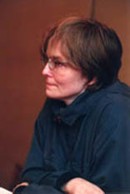 Mari Murdvee (b. 1959) is a classical philologist who works at the department of manuscripts and rare books at the Library of the University of Tartu. She also teaches Latin at the Faculty of Theology at the University and Old Greek at the Tartu Theological Academy. She is a graduate of the Drama Studio which was run by Jaan Tooming and Ăślo Vilimaa at the Theatre Vanemuine. In 1992 she staged, with the students of the Department of Classical Philology of the University the 7th Song of Homer's Odyssey, in 1994 Theocritus's Soothsayer and a recital of Sappho's poetry. In 1997 and 1998 she organized together with Heli Kohv summer seminars on ancient Greek culture called Symposion. She has translated Menandros and Aristophanes from Greek and Petrach, Horace, Hrotsvit and others from Latin. Her translations have been published by journals Akadeemia and Vikerkaar.
Mari Murdvee (b. 1959) is a classical philologist who works at the department of manuscripts and rare books at the Library of the University of Tartu. She also teaches Latin at the Faculty of Theology at the University and Old Greek at the Tartu Theological Academy. She is a graduate of the Drama Studio which was run by Jaan Tooming and Ăślo Vilimaa at the Theatre Vanemuine. In 1992 she staged, with the students of the Department of Classical Philology of the University the 7th Song of Homer's Odyssey, in 1994 Theocritus's Soothsayer and a recital of Sappho's poetry. In 1997 and 1998 she organized together with Heli Kohv summer seminars on ancient Greek culture called Symposion. She has translated Menandros and Aristophanes from Greek and Petrach, Horace, Hrotsvit and others from Latin. Her translations have been published by journals Akadeemia and Vikerkaar.
Heli Kohv
Heli Kohv is a graduate of the Tallinn School of Choreography and the Drama Studio of Jaan Tooming and Ăślo Vilimaa. Since 1981 she has been a ballet dancer at the Theatre Vanemuine. Since 1989 she has also been employed as an actor and choreographer at the Tartu Children's Theatre. In 1997 and 1998 she organized together with M. Murdvee summer seminars on ancient Greek culture called Symposion. Her greatest achievement so far has been to role of Myrrine in Lysistrata (staged by Rachid Tika in 1999).
